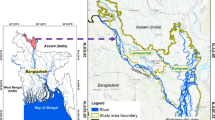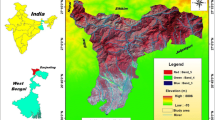Abstract
This study acknowledges the problem of land cover demarcation in diverse vegetation condition. The Normalized Difference Vegetation Index is used for the preparation of base map. Further identification of mix and incorrect classes was done using ground truth. Radar data in combination with optical indices are used. In different NDVI classes, σ°RV with additional criteria on Normalized Difference Water Index successfully demarcated waterlogged area, polarization ratio σ°RV/σ°RH and backscattering coefficient σ°RH are found suitable to separate bare land from dry grass land, sparse and dense scrub could be separated by − (σ°RV + σ°RH)/2 and NDVI is efficient to identify dense vegetation. The study area is taken as Keoladeo National Park in Bharatpur, India. Statistical similarity between ground truth and classified class has been assessed using Jaccard coefficient (JC), Jaccard distance (JD), Dice coefficient (DC) and F-score. High similarity values of JC, JD, DC and F-score are achieved for all land cover types except bare land. Although, dry grassland showed low value of F-score; the reason could be low precision of class. The overall accuracy (87.17%), producer’s accuracy (86.39%), user’s accuracy (85.81%) and Kappa Coefficient (0.84) are also utilized to analyze performance of classifier.







Similar content being viewed by others
References
Shougeng, H., & Le, W. (2012). Automated urban land-use classification with remote sensing. International Journal of Remote Sensing, 34(3), 790–803.
Qixia, M., Pinliang, D., & Huadong, G. (2015). Pixel- and feature-level fusion of hyperspectral and LIDAR data for urban land-use classification. International Journal of Remote Sensing, 36(6), 1618–1644.
Kumar, P., Prasad, R., Choudhary, A., Mishra, V. N., Gupta, D. K., & Srivastava, P. K. (2016). A statistical significance of differences in classification accuracy of crop types using different classification algorithms. Geocarto International, 32(2), 206–224.
Kumar, P., Gupta, D. K., Mishra, V. N., & Prasad, R. (2015). Comparison of support vector machine, artificial neural network, and spectral angle mapper algorithms for crop classification using LISS IV data. International Journal of Remote Sensing, 36(6), 1604–1617.
Shukla, G., Garg, R. D., Srivastava, H. S., & Garg, P. K. (2018). An effective implementation and assessment of a random forest classifier as a soil spatial predictive model. International Journal of Remote Sensing, 39(8), 2637–2669.
Shukla, G., Garg, R. D., Srivastava, H. S., & Garg, P. K. (2017). Implementation of random forest algorithm for crop prediction across an aridic to ustic area of Indian states. Journal of Applied Remote Sensing, 11(2), 026005.
Shukla, G., Garg, R. D., Srivastava, H. S., & Garg, P. K. (2016). Performance analysis of different predictive models for crop classification across an aridic to ustic area of Indian states. Geocarto International, 33(3), 240–259.
Trisurat, Y., Eiumnoh, A., Murai, S., Hussain, M. Z., & Shrestha, R. P. (2010). Improvement of tropical vegetation mapping using a remote sensing technique: A case of Khao Yai National Park. Thailand. International Journal of Remote Sensing, 21(10), 2031–2042.
Porwal, M. C., Roy, P. S., & Chellamuthu, V. (2007). Wildlife habitat analysis for ‘sambar’ (Cervus unicolor) in Kanha National Park using remote sensing. International Journal of Remote Sensing, 17(14), 2683–2697.
Schweizer, D., Armstrong, R. A., & Posada, J. (2007). Remote sensing characterization of benthic habitats and submerged vegetation biomass in Los Roques Archipelago National Park. Venezuela. International Journal of Remote Sensing, 26(12), 2657–2667.
Chamignon, C., & Manière, R. (2007). Forest cover type mapping and damage assessment of Zeiraphira diniana by SPOT 1 HRV data in the Mercantour National Park. International Journal of Remote Sensing, 11(8), 1439–1450.
Adhikari, S., Southworth, J., & Nagendra, H. (2014). Understanding forest loss and recovery: a spatiotemporal analysis of land change in and around Bannerghatta National Park, India. Journal of Land Use Science, 10(4), 402–424.
Ulaby, F. T., Bradley, G. A., & Obson, M. C. (1979). Microwave backscatter dependence on surface roughness, soil moisture, and soil texture: Part II–vegetation-covered soil. IEEE Transactions on Geoscience and Remote Sensing, 17(2), 33–40.
Ulaby, F. T., Razani, M., & Dobson, M. C. (1983). Effects of vegetation cover on the microwave radiometric sensitivity to soil moisture. IEEE Transactions on Geoscience and Remote Sensing, GE-21(1), 51–61.
Jordan, C. F. (1969). Derivation of leaf-area index from quality of light on forest floor. Ecology, 50(4), 663–666.
Huete, A. R., Justice, C., & van Leeuwen, W. (1996). MODIS vegetation index (MOD13). Algorithm theoretical basis document. http://www.ctahr.hawaii.edu/grem/mod13ug/sect0001.html. Accessed 26 July 2015.
Huete, A. R., Liu, H. Q., Batchily, K., & van Leeuwen, W. (1997). A comparison of vegetation indices global set of TM images for EOS-MODIS. Remote Sensing of Environment, 59(3), 440–451.
Gitelson, A. A. (2004). Wide dynamic range vegetation index for remote quantification of biophysical characteristics of vegetation. Journal of Plant Physiology, 161(2), 165–173.
Gitelson, A. A., Gritz, Y., & Merzlyak, M. N. (2003). Relationships between leaf chlorophyll content and spectral reflectance and algorithms for non-destructive chlorophyll assessment in higher plant leaves. Journal of Plant Physiology, 160(3), 271–282.
Dash, J., & Curran, P. J. (2004). The MERIS Terrestrial Chlorophyll Index. International Journal of Remote Sensing, 25(23), 5403–5413.
Rouse, J. W., Haas, R. H., Jr., Schell, J. A., & Deering, D. W. (1973). Monitoring vegetation systems in the Great Plains with ERTS. In 3rd ERTS-1 symposium NASA, 10–14 December 1973, Washington, D.C. (pp. 309–317).
Deschamps, B., McNairn, H., Shang, J., & Jiao, X. (2012). Towards operational radar-only crop type classification: comparison of a traditional decision tree with a random forest classifier. Canadian Journal of Remote Sensing, 38(1), 60–68.
Beltran, C. M., & Belmonte, A. C. (2001). Irrigated crop area estimation using Landsat TM imagery in La Mancha, Spain. Photogrammetric Engineering & Remote Sensing, 67(10), 1177–1184.
Sarkar, A., Majumdar, A., Chatterjee, S., Chatterjee, D., Ray, S. S., & Kartikeyan, B. (2008). Study of the potential of alternative crops by integration of multisource data using a Neuro-fuzzy technique. International Journal of Remote Sensing, 29, 5479–5493.
Kumari, M., Kumar, V., & Saha, S. K. (2015). C-band RISAT-1 data for crop growth assessment of rice. Asian Journal of Geoinformatics., 15(1), 9–14.
Long, J., Lawrence, R., Greenwood, M. C., Marshall, L., & Miller, P. R. (2013). Object-oriented crop classification using multitemporal ETM + SLC-off imagery and Random Forest. GIScience and Remote Sensing, 50(4), 418–436.
Tan, C. P., Ewe, T. H., & Chuah, H. T. (2011). Agricultural crop-type classification of multi-polarization SAR images using a hybrid entropy decomposition and Support Vector Machine technique. International Journal of Remote Sensing, 32(22), 7057–7071.
Bocco, M., Sayago, S., & Willington, E. (2014). Neural network and crop residue index multiband models for estimating crop residue cover from Landsat TM and ETM+ images. International Journal of Remote Sensing, 35(10), 3651–3663.
Toan, L. T., Beaudoin, A., Riom, J., & Guyon, D. (1992). Relating forest biomass to SAR data. IEEE Transactions on Geoscience and Remote Sensing, 30(2), 403–411.
Verhoest, N. E. C., Lievens, H., Wagner, W., Álvarez-Mozos, J., Moran, M. S., & Mattia, F. (2008). Soil roughness parameterization problem in soil moisture retrieval of bare surfaces from synthetic aperture radar. Sensors, 8(7), 4213–4248.
Huang, W., Sun, G., Ni, W., Zhang, Z., & Dubayah, R. (2015). Sensitivity of multi-source SAR backscatter to changes in forest aboveground biomass. Remote Sensing, 7(8), 9587–9609.
Sang, H., Zhang, J., Lin, H., & Zhai, L. (2014). Multi-polarization ASAR backscattering from herbaceous wetlands in Poyang Lake Region, China. Remote Sensing, 6(5), 4621–4646.
Li, P., Jiang, L., & Feng, Z. (2014). Cross-comparison of vegetation indices derived from Landsat-7 Enhanced Thematic Mapper Plus (ETM+) and Landsat-8 operational land imager (OLI) sensors. Remote Sensing, 6, 310–329.
Ippoliti-Ramilo, G. A., Epiphanio, J. C. N., & Shimabukuro, Y. E. (2003). Landsat-5 Thematic Mapper data for pre-planting crop area evaluation in tropical countries. International Journal of Remote Sensing, 24(7), 1521–1534.
Seto, K. C., & Kaufmann, R. K. (2005). Using logit models to classify land cover and land-cover change from Landsat Thematic Mapper. International Journal of Remote Sensing, 26(3), 563–577.
Alrababah, M. A., & Alhamad, M. N. (2006). Land use/cover classification of arid and semi-arid mediterranean landscapes using Landsat ETM. International Journal of Remote Sensing, 27(13), 2703–2718.
Fan, C., Zheng, S. W., & Aggarwal, R. (2014). Characterizing changes in cropping patterns using sequential Landsat imagery: An adaptive threshold approach and application to Phoenix, Arizona. International Journal of Remote Sensing, 35(20), 7263–7278.
USGS Landsat-8. (2016). Product Guide-Using the USGS Landsat 8 Product; Resource document USGS. https://landsat.usgs.gov/using-usgs-landsat-8-product. Accessed 25 June 2014.
Chávez, P. S. J. (1996). Image-based atmospheric corrections-revisited and improved. Photogrammetric Engineering & Remote Sensing, 62, 1025–1036.
Roderick, M., Smith, R. C. G., & Ludwick, G. (1996). Calibrating long term AVHRR derived NDVI imagery. Remote Sensing of Environment, 58(1), 1–12.
Hong, S. K., Nakagoshi, N., Fu, B., & Morimoto, Y. (2008). Landscape ecological application in man-influenced areas-linking man and nature systems (p. 523). New York: Springer.
Middleton, B. A. (2009). Vegetation status of the Keoladeo National Park, Bharatpur, Rajasthan, India. http://pubs.usgs.gov/sir/2009/5193/pdf/SIR2009-5193.pdf. Accessed 26 July 2015.
Gao, B. C. (1996). NDWI a normalized difference water index for remote sensing of vegetation liquid water from Space. Remote Sensing of Environment, 58(3), 257–266.
Maycira, P. F. C., & Kevin, H. T. (2006). Utilizing SAR imagery and aquatic vegetation to map fresh and brackish lakes in the Brazilian Pantanal wetland. Remote Sensing of Environment, 105(3), 204–213.
Silva, T. S. F., Costa, M. P. F., Melack, J. M., & Novo, E. M. L. M. (2008). Remote sensing of aquatic vegetation: Theory and applications. Environmental. Monitoring Assessment, 140(3), 131–145.
Santoro, M., Eriksson, L., Askne, J., & Schmullius, C. (2006). Assessment of stand-wise stem volume retrieval in boreal forest from JERS-1 L-band SAR backscattering. International Journal of Remote Sensing, 27(16), 3425–3454.
Lonnqvist, A., Rauste, Y., Molinier, M., & Hame, T. (2010). Polarimetric SAR data in land cover mapping in Boreal Zone. IEEE Transactions on Geoscience and Remote Sensing, 48(10), 3652–3662.
Lehmann, E., Zhou, Z. S., Caccetta, P., Mitchell, A., Itchell Milne, A., Lowell, K., & Mcneill, S. (2011). Combined analysis of optical and SAR remote sensing data for forest mapping and monitoring. In 7th international symposium on digital earth, 23–25 August 2011, Perth, Australia (pp. 23–25).
Acknowledgements
The authors are grateful to Keoladeo National Park Authority for providing block and species information and to Director, Keoladeo National Park for providing permission for samples collection.
Author information
Authors and Affiliations
Corresponding author
Rights and permissions
About this article
Cite this article
Shukla, G., Garg, R.D., Kumar, P. et al. Using multi-source data and decision tree classification in mapping vegetation diversity. Spat. Inf. Res. 26, 573–585 (2018). https://doi.org/10.1007/s41324-018-0200-4
Received:
Revised:
Accepted:
Published:
Issue Date:
DOI: https://doi.org/10.1007/s41324-018-0200-4




